|
 |
 Автор: Williams Автор: Williams
 Дата: 27 декабря 2018 Дата: 27 декабря 2018
 Просмотров: 487 Просмотров: 487 |
| |
Kiwa Irene Pro v4.6.3.0
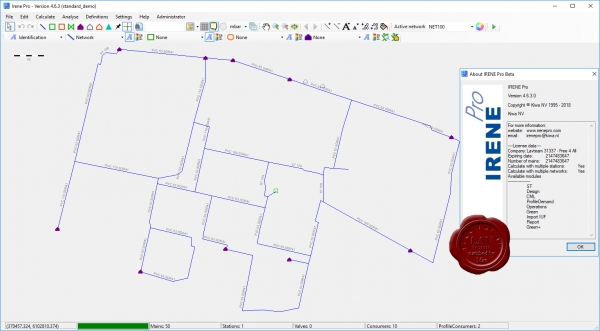
IRENE Pro is more than a gas network calculation program. It is an analysis tool for designing gas networks, performing network calculations and determining the level of risk or delivery reliability. The basic function in IRENE Pro is capacity calculation. However, extra modules can be added as required in order to extend the functionality of IRENE Pro. New modules are regularly developed in close collaboration with users and customers, leading to further expansion of the analysis options within IRENE Pro.
|
| |
 Читать статью дальше (комментариев - 7)
Читать статью дальше (комментариев - 7)
| |
|
 |
 Автор: Williams Автор: Williams
 Дата: 26 декабря 2018 Дата: 26 декабря 2018
 Просмотров: 1 883 Просмотров: 1 883 |
| |
APF Nexus WoodJoint v3.4
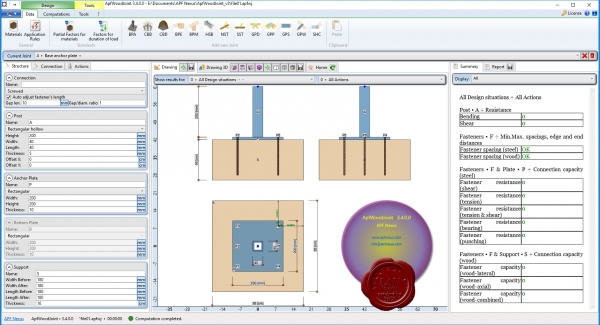
APF WoodJoint lets you design traditional carpentry connections or modern timber joints (nailed, screwed, bolted) in accordance Eurocode 5 (EC5). All you have to do is specify the dimensions, the configuration and the actions. APF WoodJoint performs all the required checks for ULS, according to Eurocode 5. The results are displayed in the graphic environment and the user can save a detailed report with calculations and images. The user interface is designed to simplify your work. You can change every value (size of the structural members, fastener type, etc.), recalculate, and the results are immediately available. All the design variables, such as load coefficients, material properties (mechanical properties of timber and fasteners), can be adjusted by you, according to your needs (or the requirements of any National Standard or National annex to the Eurocodes). APF WoodJoint performs a structural analysis of the connection, examining the fastener as well as the connected members. The forces acting on the structural elements are displayed by the graphical interface, for each load case separately. APF WoodJoint lets you design many types of connections: carpentry joints (front notched joint, mortise and tenon joint, with stirrups and tension ties), steel-plate to timber connections (bolts with side gusset steel plates, apex plate, heel plate, point plate, slice plate), connections to supporting beams (with screws, steel hangers, steel angles, dovetails). |
| |
 Читать статью дальше (комментариев - 10)
Читать статью дальше (комментариев - 10)
| |
|
 |
 Автор: Williams Автор: Williams
 Дата: 24 декабря 2018 Дата: 24 декабря 2018
 Просмотров: 1 793 Просмотров: 1 793 |
| |
ProSim Simulis Thermodynamics v2.0.25.0 + Component Plus v3.6.0.0
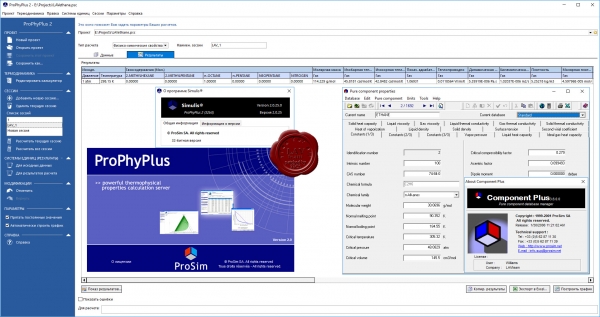
Interoperability, integration, reusability. Simulis Thermodynamics allows anyone in industry, engineering or research to run high quality thermophysical properties calculations. These calculations can be plugged in any software of wider application range (equipment sizing, system modeling, etc) and properties are available for any kind of fluid. Simulis Thermodynamics makes open simulation a practical reality.
Simulis Thermodynamics is a calculation server for thermophysical properties and phase equilibria calculations on pure components and mixtures. It is available as a Microsoft Excel add-in, a toolbox in MATLAB or as a software component which can be easily plugged in any other application requiring reliable and accurate thermophysical properties.
Simulis Thermodynamics provides engineers and software developers with an accurate and reliable thermophysical properties calculation server. These calculations can be integrated in any package intended for wider fields of application (equipment sizing, system modeling, etc) in order to ensure the consistency and reliability the data used and of the results. Simulis Thermodynamics is designed to:
- Provide access to over 300 functions, in particular for calculation of any type of transport properties (specific heat, viscosity,...), of thermodynamic properties (enthalpy, compressibility factor ...) or of phase equilibria (VLE, LLE, VLLE, salt formation ...) on multi component mixtures.
- Provide access to one of the richest thermodynamic models libraries available on the market (equation of state, activity coefficients ...)
- Provide access to a property database of more than 2300 pure components.
- Enable the engineer to focus on their application and to work with thermophysical properties calculations that are reliable, and validated through intensive usage in industrial applications.
In support of your thermodynamic expertise, Simulis Thermodynamics will enable you to:
- Use the best thermodynamic representation of your system.
- Perpetuate your expertise with easily created "Property Packages" that include all elements needed for further calculations (pure components properties, models, interaction coefficients ...)
- Distribute these "Property Packages" throughout your organization in order for them to be used in your usual, CAPE-OPEN compliant, software.
|
| |
 Читать статью дальше (комментариев - 6)
Читать статью дальше (комментариев - 6)
| |
|
 |
 Автор: Williams Автор: Williams
 Дата: 23 декабря 2018 Дата: 23 декабря 2018
 Просмотров: 1 787 Просмотров: 1 787 |
| |
APF Nexus WoodTruss v3.3
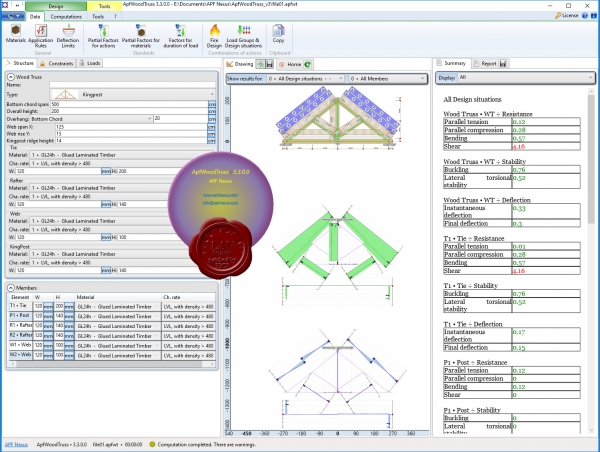
APF WoodTruss lets you design timber trusses (King post, Fink, Howe), according to Eurocode 5 (EC5). All You have to do is specify the dimensions, the constraints and the loads. APF WoodTruss creates the load combinations according to Eurocode 0 and Eurocode 1 and performs all the required checks for ULS and SLS. APF WoodTruss reports warns you in case of unacceptable design of the timber structure. The results are displayed in the graphic environment and the user can save a detailed report with calculation details and images. The user interface is designed to simplify your work. You can change every value (cross sections’ size, truss span, etc.), recalculate and the results are immediately available. All the design variables, such as load coefficients, material properties (mechanical properties of timber) can be adjusted by you, according to your needs (or the requirements of any National Standard or National annex to the Eurocodes). APF WoodTruss performs a finite element analysis of the timber truss, as a two dimensional timber structure, with the supports having the degree of stiffness selected by the user. Internal forces, support reactions and deflections are displayed by the graphical interface separately for each load case. APF WoodTruss performs structural fire design according to Eurocode 5, using the reduced cross section method, for both unprotected and protected surfaces. Surfaces can be protected by fire protective claddings whose properties are defined by the user. |
| |
 Читать статью дальше (комментариев - 13)
Читать статью дальше (комментариев - 13)
| |
|
 |
 Автор: Williams Автор: Williams
 Дата: 21 декабря 2018 Дата: 21 декабря 2018
 Просмотров: 1 642 Просмотров: 1 642 |
| |
APF Nexus WoodBeam v4.4
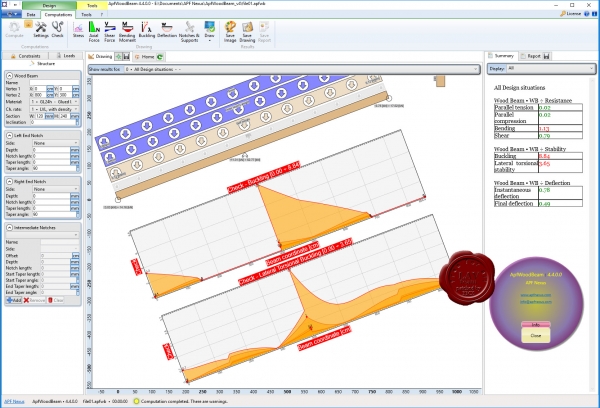
PF WoodBeam lets you design timber beams (simply supported or continuos), in accordance with Eurocode 5 (EC5). All you have to do, is to specify the dimensions, the constraints, and the loads. APF WoodBeam creates the load combinations, according to Eurocode 0 and Eurocode 1, and performs all the required checks for ULS and SLS. APF WoodBeam warns you in case of unacceptable design of the timber structure. The results are displayed in the graphic interface and the user can save a detailed report with calculation summary and images. The user interface is designed to simplify your work. You can change every value (cross section size, timber beam length, etc.), recalculate, and the results are immediately available. All the design variables, such as load coefficients, material properties (mechanical properties of timber), can be adjusted by you, according to your needs (or the requirements of any National Standard or National Eurocodes Annexes). APF WoodBeam performs a finite element analysis of the timber beam, as a two dimensional timber structure, with the supports having the degree of stiffness selected by the user. Internal forces, support reactions, and deflections are displayed by the graphical interface for each load case separately. APF WoodBeam performs structural fire design according to Eurocode 5, using the reduced cross section method for both unprotected and protected surfaces. Surfaces can be protected by fire protective claddings whose properties are defined by the user. |
| |
 Читать статью дальше (комментариев - 8)
Читать статью дальше (комментариев - 8)
| |
|
 |
 Автор: Williams Автор: Williams
 Дата: 20 декабря 2018 Дата: 20 декабря 2018
 Просмотров: 840 Просмотров: 840 |
| |
Bentley LEGION R6.5.3
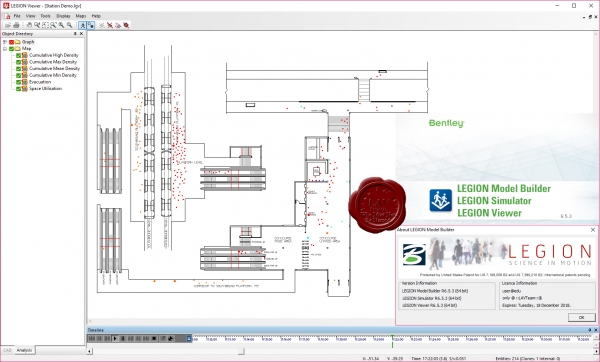
Создавайте модели прогнозируемой пропускной способности для разных сценариев и изучайте, как пешеходы и толпы взаимодействуют с инфраструктурой. Выполняйте виртуальные эксперименты по проектированию и эксплуатации объекта и оценивайте влияние пешеходных потоков различной интенсивности. Благодаря возможностям комплексного моделирования, анализа и визуализации для различных проектов – от аэропортов до железнодорожных станций и спортивных центров – LEGION Simulator помогает оптимизировать пешеходный поток и повысить безопасность, позволяя пользователям тестировать стратегии эвакуации на любом этапе моделирования.
Научная обоснованность: LEGION Simulator опирается на обширные научные исследования поведения пешеходов в реальных условиях. Алгоритмы являются запатентованными, а результаты моделирования соответствуют эмпирическим измерениям и качественным исследованиям.
Совместимость: интеграция с другими приложениями для лучшего понимания взаимодействия пешеходов и транспортных средств, а также изменения поведения в зависимости от температуры и других переменных.
Точные отчеты: экспорт и создание отчетов с помощью карт, графиков и видеороликов для точного информирования участников проекта о плотности пешеходного потока, эвакуации, использовании пространства, социальных издержках и предпочитаемых маршрутах. |
| |
 Читать статью дальше (комментариев - 7)
Читать статью дальше (комментариев - 7)
| |
|
 |
 Автор: Williams Автор: Williams
 Дата: 18 декабря 2018 Дата: 18 декабря 2018
 Просмотров: 11 547 Просмотров: 11 547 |
| |
Bentley MicroStation CONNECT Edition Update 11 Version 10.11.00.36
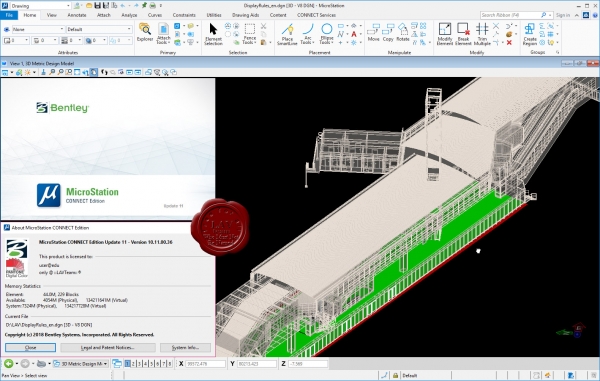
MicroStation - самая производительная, наиболее доступная и совместимая САПР-платформа для проектирования, строительства и эксплуатации мировой инфраструктуры.
Вам, вероятно, известно, что 95% инфраструктуры в мире проектируется, строится и поддерживается с применением файлов форматов DGN и DWG. При помощи MicroStation пользователи имеют возможность непосредственно редактировать содержимое обоих форматов файлов одновременно. Эта возможность превращает MicroStation в платформу для обеспечения совместимости, являющуюся обязательным атрибутом.
MicroStation также является платформой для инноваций, расположенной в центре полного спектра вертикальных программных приложений, обеспечивающей пользователей возможностью индивидуализации приложений с помощью VBA, а также возможностью "вертикального роста" при помощи узкоспециализированных решений для увеличения производительности при поддержании полной целостности данных по всему проекту.
С учетом лишь из этих двух соображений, то, что MicroStation используется всеми, включая архитекторов, инженеров, картографов и подрядчиков по проектам в области архитектуры, строительства и инженерного проектирования, не должно вызывать удивления. За счет этого данная система становится стандартом для лучших проектировщиков мира, являющихся участниками рейтинга ENR Global 150. |
| |
 Читать статью дальше (комментариев - 33)
Читать статью дальше (комментариев - 33)
| |
|
 |
| ПОИСК ПО САЙТУ |
 |
|
 |
| КАЛЕНДАРЬ | | |
 |
| « Октябрь 2025 » |
|---|
| Пн | Вт | Ср | Чт | Пт | Сб | Вс |
|---|
| | 1 | 2 | 3 | 4 | 5 | | 6 | 7 | 8 | 9 | 10 | 11 | 12 | | 13 | 14 | 15 | 16 | 17 | 18 | 19 | | 20 | 21 | 22 | 23 | 24 | 25 | 26 | | 27 | 28 | 29 | 30 | 31 | |
|
 | |
| |
|